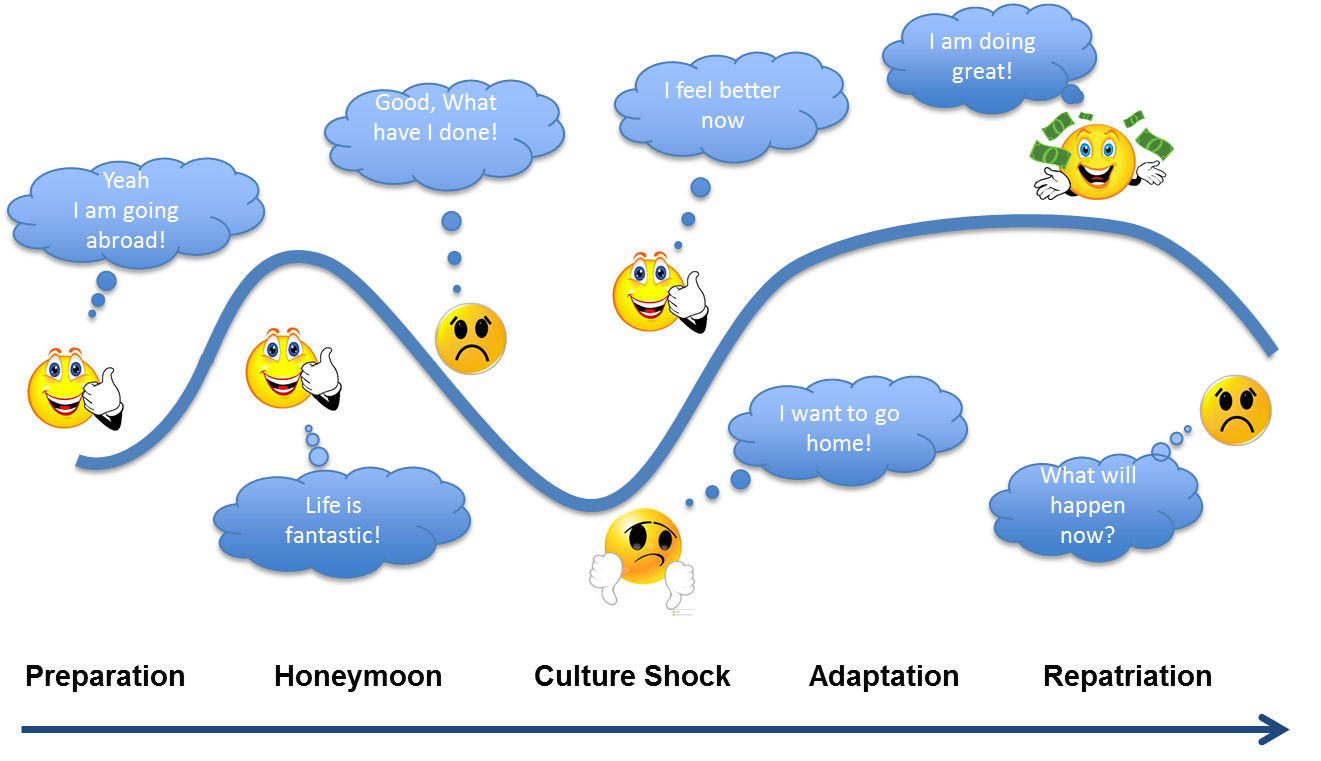
Research and expatriate experience testify to the fact that while each international assignment is unique, there is an identifiable pattern of ups and downs that relocating families typically go through. This process is often referred to as the …
… “Adjustment Cycle” or “Cross-Cultural Adjustment Cycle”, which has normally more or less 4-6 phases involved. I will use the term “Expat Lifecycle” and focus on four phases plus an additional phase for repatriation, applicable for many assignments.


The first phase in the Expat Lifecycle is the preparation phase, where there is excitement about the new life ahead, tempered by anxiety about leaving an established life and loved ones behind. It is not unusual for the employee to formally start the new position well before the family has transferred, in some cases even several months ahead the full relocation. This of course separates the normality and stretches the relocation phase further, implying more stress and abnormality keeping family relations together. Still this is a positive up-going phase for most families.

Second phase, is referred to as the honeymoon. This is in the very beginning, when the assignee has arrived with or without family to the new home country. Living in a hotel or temporary accommodation, many times covered by an expense allowance, they can opt to visit an international restaurant rather than the local supermarket, and go by taxi rather than navigating the public transport network. It is like a honeymoon, as like the newlyweds who relax on the beach, this temporary idyll bears no relation to the challenges ahead. It can be perceived as some sort of extended vacation, even though the assignee is working, as you are relieved from the responsibilities and routines of everyday life.


Third phase, culture shock is entered into when the assignee and family slowly transfers to normal everyday life at the new location. The experiences and symptoms vary widely of course, depending on cultural differences and personal adaptability. But at this stage when trying to adapt to the local life, expats are beginning to missing certain aspects of life at home, feeling discomfort with the local cultural values and/or norms, struggles and inability to communicate in the local language in everyday life and many times frustration navigating local bureaucracy to get work permits, drivers licenses or just hiring a household help. The absence of family and old friends amplifies the discontent, not having anyone to unburden and support you in your setbacks and challenges.

 In the final and fourth phase, adaptation finally sets in. This is when the return of investment occurs for the expat family, following a period of tremendous upheaval and a steep learning curve; the transferring employee finally is becoming productive in the new environment. Family members become settled and learn to appreciate the new culture and the expatriate lifestyle. They have acquainted themselves with the local culture enough to feel confident, the language barriers are not a big issue anymore, they have made friends and grown social networks and there is true sense of home feeling for the entire family allowing them to breathe again.
In the final and fourth phase, adaptation finally sets in. This is when the return of investment occurs for the expat family, following a period of tremendous upheaval and a steep learning curve; the transferring employee finally is becoming productive in the new environment. Family members become settled and learn to appreciate the new culture and the expatriate lifestyle. They have acquainted themselves with the local culture enough to feel confident, the language barriers are not a big issue anymore, they have made friends and grown social networks and there is true sense of home feeling for the entire family allowing them to breathe again.
 The Expat Lifecycle would not be complete without taking repatriation into account, why I also mention a fifth phase. Families that have been abroad for some years and especially on successive international assignments, the process of returning home can be as arduous and traumatic as the initial relocation. The home environment to which they are returning may have changed considerably. The frame of reference they have of “home” is not what it appears to be anymore when returning back. The assignees as well as the family have problems adjusting back to “normal life” again. Their international experience is perhaps not appreciated to the extent they would expect and people around them have a different reality than they perceive. It’s a cultural transition again, but on home soil.
The Expat Lifecycle would not be complete without taking repatriation into account, why I also mention a fifth phase. Families that have been abroad for some years and especially on successive international assignments, the process of returning home can be as arduous and traumatic as the initial relocation. The home environment to which they are returning may have changed considerably. The frame of reference they have of “home” is not what it appears to be anymore when returning back. The assignees as well as the family have problems adjusting back to “normal life” again. Their international experience is perhaps not appreciated to the extent they would expect and people around them have a different reality than they perceive. It’s a cultural transition again, but on home soil.
All international assignees and expats go through these phases during their adjustment process abroad, some much quicker and smoother than others, but still experiencing all phases at one point of time.
Understanding the stages of the expatriate adjustment lifecycle, “the expat lifecycle”, from pre-departure through culture shock and adjustment to eventual repatriation, is a very powerful model to structure HR services around. If HR is aware of the distinct phases and what the assignee with family goes through, they can actively support each phase in the right way with the right means, resulting in more satisfied transferees and better talent retention. Failing to acknowledge the stages in the expat lifecycle by HR can be fatal for the expat family and thus the organization.

 Seite drucken
Seite drucken